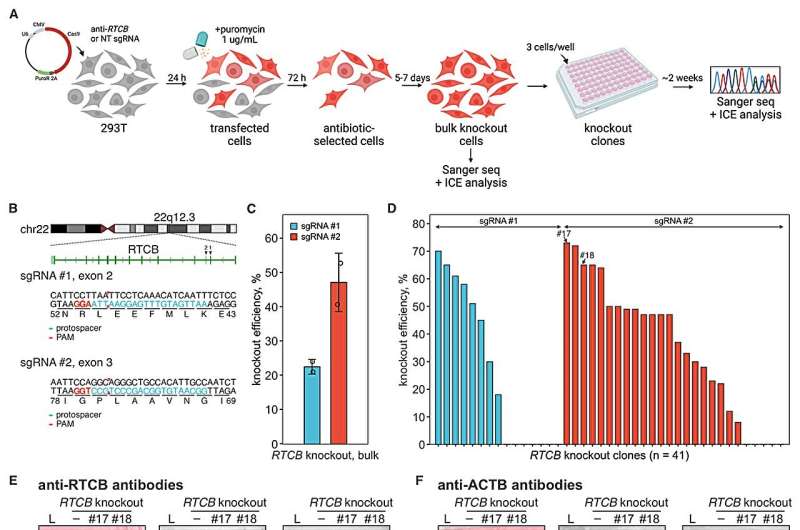This article has been reviewed according to Science X's editorial process and policies. Editors have highlighted the following attributes while ensuring the content's credibility:
fact-checked
peer-reviewed publication
trusted source
proofread
Scientists' research on RNA editing illuminates possible lifesaving treatments for genetic diseases

A team at Montana State University published research this month that shows how RNA, the close chemical cousin to DNA, can be edited using CRISPRs. The work reveals a new process in human cells that has potential for treating a wide variety of genetic diseases.
Postdoctoral researchers Artem Nemudryi and Anna Nemudraia conducted the research alongside Blake Wiedenheft, professor in the Department of Microbiology and Cell Biology in MSU's College of Agriculture. The paper, titled "Repair of CRISPR-guided RNA breaks enables site-specific RNA excision in human cells," was published online on April 25 in the journal Science and constitutes the latest advance in the team's ongoing exploration of CRISPR applications for programmable genetic engineering.
CRISPR, which stands for Clustered Regularly Interspaced Short Palindromic Repeats, is a type of immune system that bacteria use to recognize and fight off viruses. Wiedenheft, one of the nation's leading CRISPR researchers, said that the system has been used for years to cut and edit DNA, but that applying similar technology to RNA is unprecedented.
DNA editing uses a CRISPR-associated protein called Cas9, while editing RNA requires the use of a different CRISPR system, called type-III.
"In our previous work, we used type-III CRISPRs to edit viral RNA in a test tube," said Nemudryi. "But we wondered, can we program manipulation of RNA in a living human cell?"
To explore that question, the team programmed type-III CRISPR proteins to cut RNA containing a mutation that causes cystic fibrosis, restoring cell function.
"We were confident that we could use these CRISPR systems to cut RNA in a programmable manner, but we were all surprised when we sequenced the RNA and realized that the cell had stitched the RNA back together in a way that removed the mutation," said Wiedenheft.
Nemudryi noted that RNA is transient within the cell; it is constantly being destroyed and replaced.
"The general belief is that there's not much point in repairing RNA," he said. "We speculated that RNA would be repaired in living human cells, and it turned out to be true."
Wiedenheft has mentored the two postdoctoral researchers since their arrival at MSU nearly six years ago, and said that the impact of their scientific contributions will lead to significant and continued advancements.
"The work done by Artem and Anna suggests that RNA repair might be a fundamental aspect of biology and that harnessing this activity may lead to new lifesaving cures," said Wiedenheft. "Artem and Anna are two of the most brilliant scientists I have ever encountered, and I'm confident that their work is going to have a lasting impact on humanity."
RNA editing has important applications in the search for treatments of genetic diseases, Nemudryi said. RNA is a temporary copy of a cell's DNA, which serves as a template. Manipulating the template by editing DNA could cause unwanted and potentially irreversible collateral changes, but because RNA is a temporary copy, he said, edits made are essentially reversible and carry far less risk.
"People used Cas9 to break DNA and study how cells repair these breaks. Then, based on these patterns, they improved Cas9 editors," said Nemudraia. "Here, we hope the same will happen with RNA editing. We created a tool that allows us to study how the cells repair their RNA, and we hope to use this knowledge to make RNA editors more efficient."
In the new publication, the team shows that a mutation causing cystic fibrosis can be successfully removed from the RNA. But this is only one of thousands of known mutations that cause disease. The question of how many of them could be addressed with this new RNA editing technology will guide future work for Nemudryi and Nemudraia as they finish their postdoctoral training at MSU and prepare for faculty positions at the University of Florida this fall. Both credited Wiedenheft as a life-changing mentor.
"Blake taught us not to be afraid of testing any ideas," said Nemudraia. "As a scientist, you should be brave and not be afraid to fail. RNA editing and repair is the terra incognita. It's scary but also exciting. You feel you're working on the edge of science, pushing the limits to where nobody has been before."
More information: Anna Nemudraia et al, Repair of CRISPR-guided RNA breaks enables site-specific RNA excision in human cells, Science (2024). DOI: 10.1126/science.adk5518
Journal information: Science
Provided by Montana State University




















